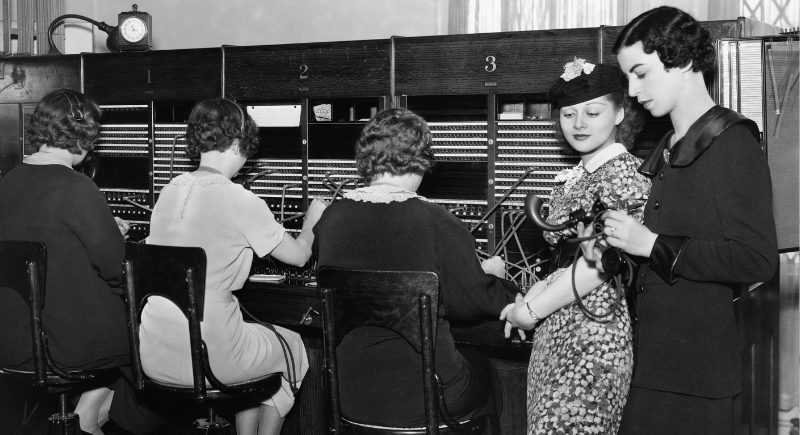40 Jobs Most Likely to Be Replaced By AI, According to Microsoft Study
What once sounded like science fiction is rapidly turning into everyday reality. As technology sharpens its edge, entire roles are quietly shrinking or disappearing. The shift is already here, and it is reshaping how work gets done. Let’s explore the jobs most vulnerable as automation proves it no longer needs a human at the keyboard.
Data Entry Clerk

Credit: Getty Images
Most data entry jobs have disappeared behind software. Companies use machine learning and OCR to pull information straight from forms and images into their databases. The result is fewer manual keystrokes and fewer errors. What used to take an entire department now happens in the background, with barely any human input. Data entry as a career is fading fast.
Payroll Administrator

Credit: Canva
Payroll’s gone digital, and it’s bringing AI to the HR breakroom. The need for human number crunchers is dwindling, with automated systems improving accuracy by up to 20% and self-service portals letting employees pull their payslips. Even routine paycheck questions are handled by chatbots now.
Appointment Scheduler

Credit: Getty Images
AI scheduling tools analyze thousands of data points, such as appointment lengths, patient histories, and no-show risks, to build smarter calendars. They are Integrated with health records and billing platforms, which enable them to eliminate the need for humans to juggle time slots across systems. The result? Fewer staff, faster bookings, and fewer errors.
Information and Records Clerk

Credit: Canva
Filing cabinets are obsolete. AI now classifies, stores, and retrieves records faster and more securely than humans ever could. OCR and automated workflows handle tasks like document sorting, retention tracking, and compliance audits with precision. Organizations benefit from lower costs and minimal errors, which means fewer clerks are needed in the loop.
Virtual Receptionist

Credit: Canva
Your friendly front-desk voice might already be synthetic. Virtual receptionists use natural language processing to answer calls, book appointments, and respond to questions, day or night. They handle massive call volumes without breaks or sick days. The more routine the task, the more likely AI is to own it now.
Transcriptionist

Credit: Canva
If you’ve ever seen AI turn an interview into text in seconds, you know the game has changed. Tools now offer variable playback, audio alignment, and multi-speaker labeling. While humans still polish transcripts, robotics handles the bulk, making traditional transcription work less essential and less common.
Order Processing Agent

Credit: Getty Images
Manual order entry is fading fast. AI captures order data, predicts stock needs, and tracks shipments in real time. Platforms like ZBrain help companies process more with fewer people by scaling AI agents instead of hiring staff.
Claims Processor

Credit: Canva
Weeks-long claims are shrinking to minutes. Algorithms now verify information, detect fraud, and match data patterns that humans often miss. Faster processing with fewer mistakes means fewer people are needed to push paperwork. The result is speed, accuracy, and a leaner team, which makes traditional claims processing jobs less secure.
Paralegal (for Basic Legal Research)

Credit: pexels
Legal firms are letting AI handle the boring stuff. Tools can draft documents, search legal databases, and even summarize case law. Routine research that took hours is done in seconds. It’s not replacing top legal minds, but for basic tasks, AI is cheaper, accurate, and faster.
Telephone Operators

Credit: pexels
Today, AI can troubleshoot, connect callers, and offer support without missing a beat or a ring. Most customer queries don’t need a person anymore, and telecom jobs focused on human interaction are being squeezed out as real-time support is handed over to machines.
Junior Web Developer

Credit: pexels
Tools like GitHub Copilot or Replit generate entire code blocks from simple prompts. Add AI-powered website builders and automated testing to the mix, and junior roles start looking less necessary. It’s not replacing senior devs yet, but entry-level coding is under pressure.
Software QA Tester

Credit: pixelshot
AI also has got skills for bug hunting. Tools can scan codebases, auto-generate test cases, and adapt to UI changes without human help. They’re faster, more thorough, and never bored of clicking the same button 300 times. This means fewer testers are needed for routine QA, especially when AI finds what humans might miss.
Basic IT Support Technician

Credit: Canva
Forget waiting on hold for a password reset. AI-powered self-service portals and predictive support systems now guide users through issues instantly. Machine learning spots problems before they escalate, and companies need fewer techs for basic troubleshooting.
Technical Documentation Writer

Credit: Getty Images
AI checks grammar, suggests consistent terminology, restructures content, and even analyzes readability. It can translate, localize, and repurpose documentation for different audiences. Even though people still shape the message, AI handles the repetitive grunt work, trimming the time and team size once needed for large-scale documentation projects and writers.
SEO Specialist

Credit: pexels
Today, tools handle everything, including keyword research and ranking analysis, and they’re scary good at it. That means less manual work for SEO pros focused on data-driven tasks. The shift is that not so many specialists are required for strategy and creative thinking, because machines have the routine stuff down cold.
Video Editor

Credit: Getty Images
Editing is changing as software now trims footage, corrects colors, adds captions, and even recommends music—all with minimal human input. These tools personalize videos for individual viewers and streamline bulk edits, which means less grunt work for editors and more automation behind the scenes of your favorite content.
Social Media Manager (for Basic Tasks)

Credit: Canva
Scheduling posts, researching hashtags, and analyzing metrics are being handled by digital tools that learn and adapt. They create captions, generate visuals, and optimize posting times without needing constant oversight. As automation covers the basics, the role shifts toward creative direction and brand storytelling, not repetitive content chores.
Voice-over Artist

Credit: Getty Images
A computer can now deliver a script with clarity and emotion. Most phone prompts and routine explainer videos use these digital voices. Studios that once needed dozens of readers now let the software handle standard jobs. For basic narration, human voice work is slipping out of demand.
UX Tester (for Standardized Feedback)

Credit: Canva
Presently, survey creation, click tracking, and user flow analysis run on autopilot. Systems collect and interpret behavior data at scale, identifying patterns and usability snags without a research team. For routine interface feedback, many of the difficult tasks no longer require someone watching test subjects in a lab.
Email Marketing Specialist

Credit: Getty Images
Automated platforms clean lists, personalize content, and schedule messages with uncanny timing. Algorithms predict customer behavior, draft subject lines, and even tweak layouts. Campaigns are optimized before a human even hits “send,” shifting the focus toward strategy and storytelling instead of manual list sorting, hence limiting the required number of specialists.
Cashier

Credit: Canva
Checkout has changed. Self-scanning stations and payment apps now handle transactions independently, without needing someone at the register. Some stores even track what you grab and bill you as you leave. This tech, for example, Zippin’s slashes wait times—and the number of humans managing tills.
Parking Lot Attendants

Credit: Getty Images
Parking lot attendants’ jobs are likely to be replaced by AI through the use of smart parking systems and automated technologies. AI-powered cameras and sensors can detect vehicle entry and exit, monitor parking space availability, and identify violations, automating many tasks currently performed by attendants.
Retail Inventory Associate

Credit: Lifestock
Stock levels are tracked by drones or scanned in real time using intelligent systems. They alert managers before items run low, automate reordering, and even forecast demand changes. Tasks like shelf-checking or barcode scanning now require fewer hands and more sensors. AI can also be used to adjust prices based on demand and competition.
Fast-Food Order Taker

Credit: Getty Images
Touchscreens and chatbots currently handle menu browsing, customizations, and payment. Some fast food giants and drive-thrus even feature self-cleaning machines and voice assistants taking orders with near-human fluency.
Call Center Agent

Credit: Getty Images
Smart systems now handle thousands of customer queries through chat or voice. They offer solutions, process requests, and escalate only the unusual stuff. Routine calls, once handled by full teams, are managed efficiently, reducing staffing needs and call times across the board. Conversational AI agents like Convin’s are the new order.
Telemarketers

Credit: Getty Images
Sales calls are generated by systems that can pitch products, answer objections, and schedule follow-ups. These tools operate nonstop, don’t need breaks, and work at scale, making large cold-calling teams unnecessary. With full workflows handled automatically, this role faces one of the highest risks of vanishing completely.
Travel Agent (for Basic Bookings)

Credit: Canva
Flights, hotels, and rental cars can all be booked through intelligent assistants that adjust plans in real time. They respond to delays, weather changes, and customer preferences instantly. Basic itinerary planning now requires fewer human hands, especially when immediate recommendations and updates are part of the package.
Helpdesk Responder

Credit: Getty Images
Responsive systems like chatbots handle password resets, basic troubleshooting steps, account unlocks, and FAQs without needing to sleep. They provide instant support, solve common issues, and escalate only when necessary. This round-the-clock convenience makes large human support teams less essential for routine help desk tasks.
Warranty Claims Specialist

Credit: Getty Images
Systems verify eligibility, assess damage, and approve claims with impressive speed. They detect fraud by spotting suspicious patterns that might slip past humans. With fewer simple claims requiring manual review, specialists are shifting toward oversight or more complex cases, if the role remains at all.
Switchboard Operators

Credit: Canva
As AI technology becomes more sophisticated, the need for manual call routing through a switchboard will diminish. Automated systems answer calls, gather information, and route connections without assistance. Interactive menus and virtual reception tools handle most inbound requests quickly. Manual routing tasks that once needed human judgment are now performed at scale and with greater consistency.
E-commerce Chat Agent

Credit: pexels
Order tracking, returns, and product questions are today managed by tools that simulate natural conversation. These systems can resolve multiple issues at once, personalize responses, and remember customer history. Routine inquiries that once filled entire shifts are now handled in seconds, requiring less human intervention.
News Reporter (for Templated Reports)

Credit: Getty Images
Game scores, stock updates, and earnings summaries are generated directly from data feeds. These stories follow predictable formats, making them ideal for automation. This allows reporters to focus on deeper stories while reducing the need for human involvement in daily, structured reporting and eventual labor needs.
Copywriter (for Ads and Short-Form Content)

Credit: pexels
Text like ad headlines, product blurbs, and promotional emails can now be drafted in seconds through automation. They often mimic brand tone and structure closely enough to pass without edits. While creativity still matters, much of the routine copywriting workload is shrinking rapidly and may soon vanish.
Proofreader

Credit: Getty Images
AI proofreading tools can check grammar and suggest ways to simplify complex sentences. They can also adjust tone to align with a brand’s voice or target audience. Much like standard spellcheckers, they can identify and correct punctuation, spelling, word choice, and formatting errors, gradually reducing the need for human proofreaders.
Technical Manual Writer

Credit: pexels
Guides like how-tos and spec sheets are increasingly drafted with assistance from systems trained to recognize jargon and structure. They check for accuracy, suggest improvements, and standardize formatting. This speeds up production and cuts back on the number of writers needed for large documentation projects.
Brokerage Clerks

Credit: Canva
Report generation, data sorting, and initial financial analysis are done automatically today. These systems operate faster and with fewer errors, reducing the need for manual input. With so many routine tasks removed from the workflow, the demand for clerical roles in brokerage firms is declining steadily.
Concierges

Credit: Getty Images
Digital assistants can now manage booking reservations, give directions, and handle maintenance requests. The tools offer 24/7 support, pull data from guest preferences, and manage more requests than a single person could. The traditional concierge desk is becoming more of a backup than a first stop.
Ad Jingle Composer

Credit: Canva
Music creation no longer starts with a blank page. Tools now analyze popular trends and generate catchy tunes in seconds, perfect for quick ad turnarounds. Composing short branded melodies and TV shows requires less manual work, and that means fewer jobs scoring commercials from scratch.
Personal Financial Advisors

Credit: Getty Images
Many people now get their investment advice from apps, not an advisor across the desk. Algorithms track the markets and adjust portfolios on the fly, so no meetings are required. If the question is simple—where to put your money, when to shift funds—a computer usually answers it. Personal advice still matters, but for most clients, the human touch is fading.
Models

Credit: pexels
Photoshoots without people? It’s happening. Digital 3D models can wear clothes, strike poses, and look camera-ready without ever stepping in front of a lens. For catalogs and online stores, this means fewer bookings, faster production, and lower costs compared to using human models. Another profession is going down.